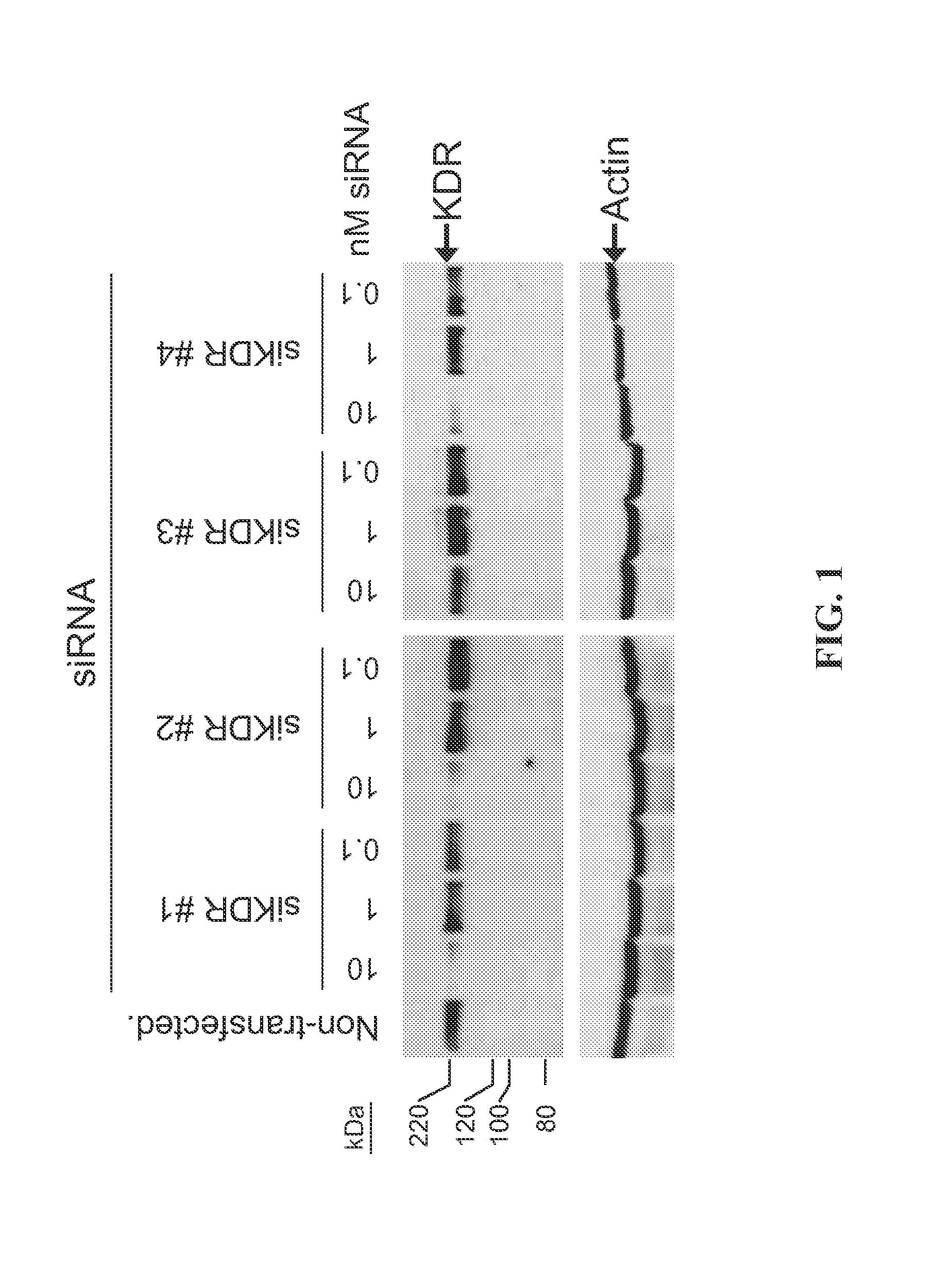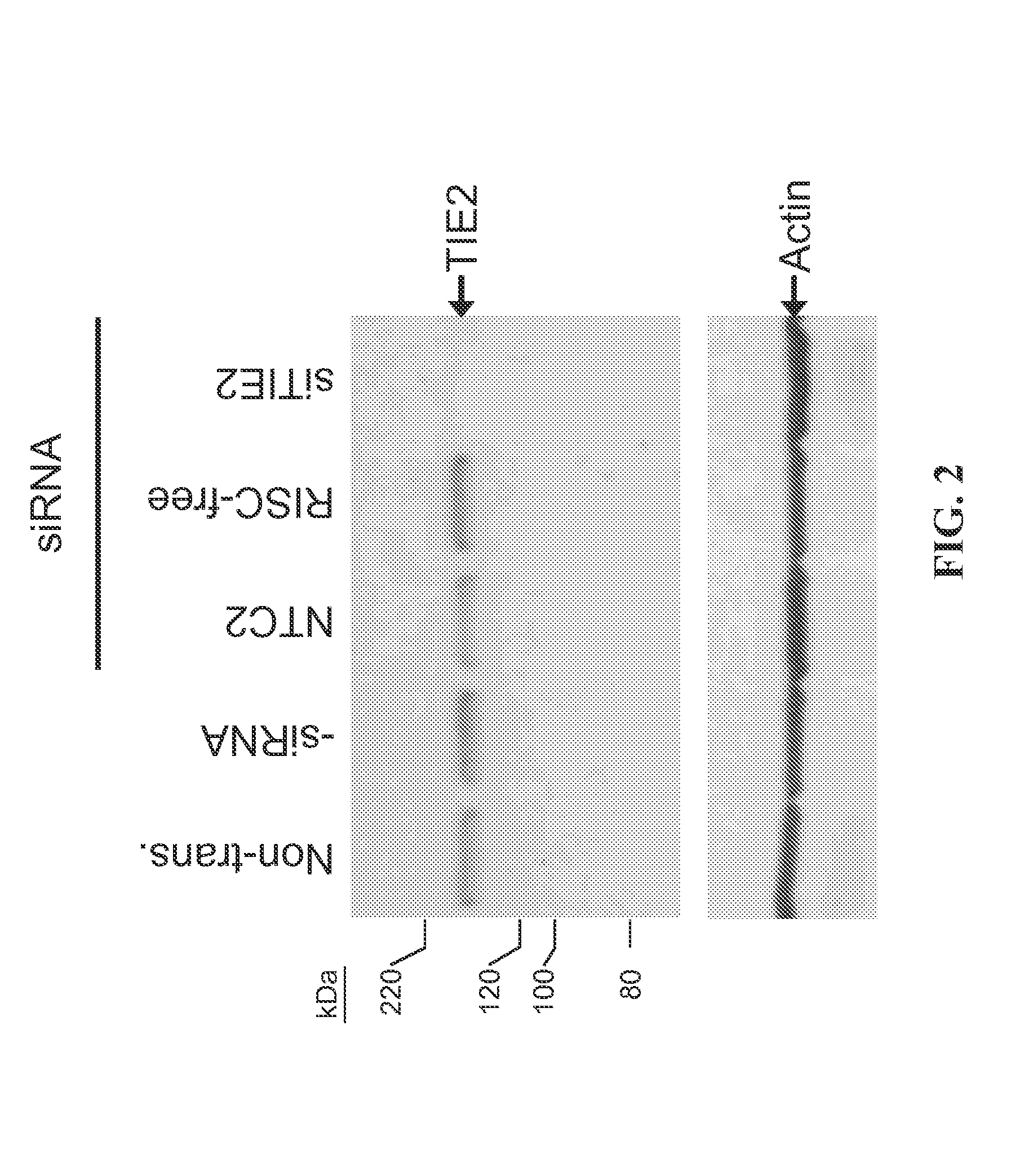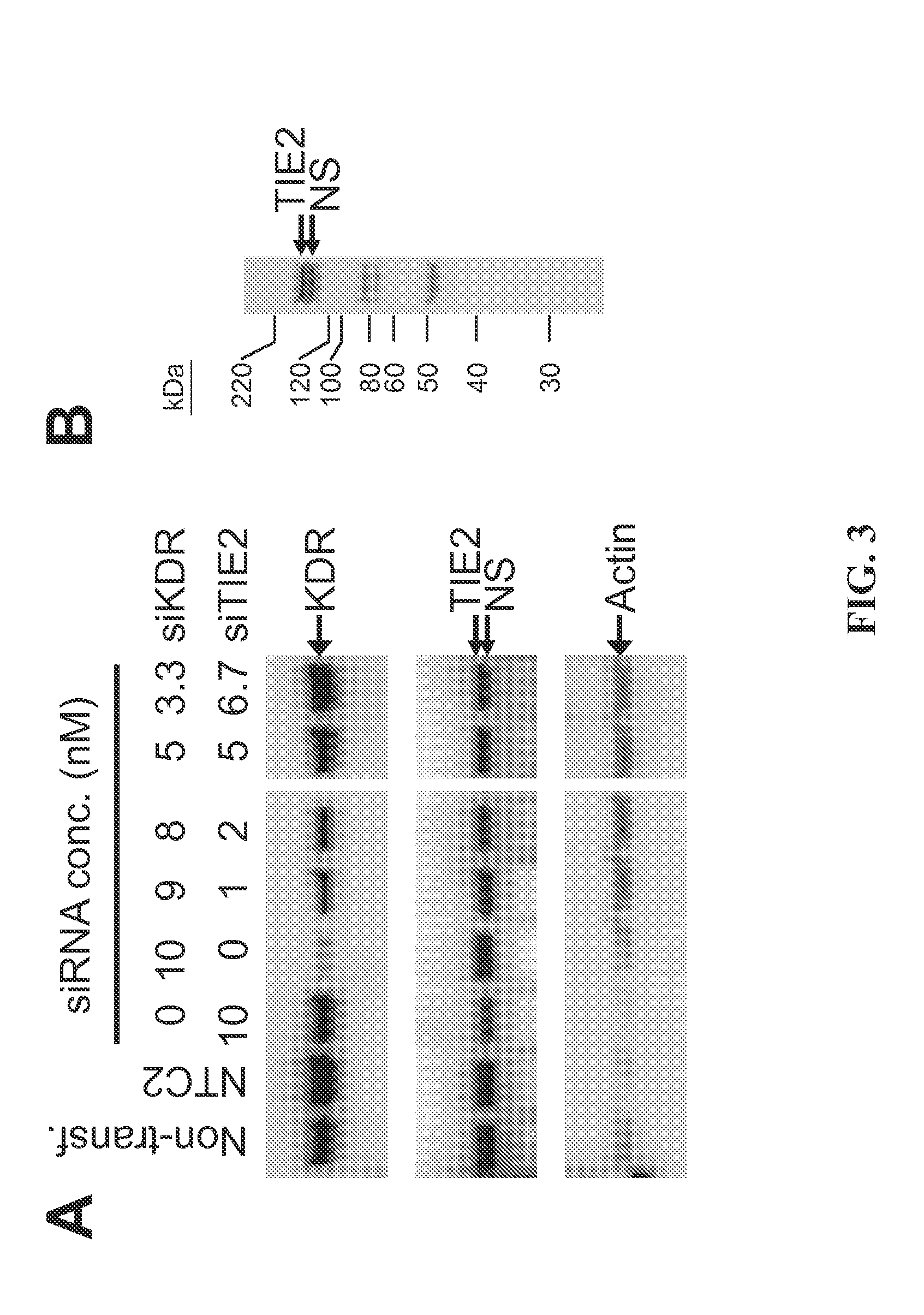RNAi-MEDIATED INHIBITION OF SELECT RECEPTOR TYROSINE KINASES FOR TREATMENT OF PATHOLOGIC OCULAR NEOVASCULARIZATION-RELATED CONDITIONS
a select receptor and kinase technology, applied in the direction of fermentation, plant genotype modification, biochemistry apparatus and processes, etc., can solve the problems of tissue edema, affecting differentiation process, wet or exudative amd, etc., to reduce signal transduction downstream processes, prevent or intervene high potent and effective, and reduce the effect of ocular pre-angiogenic and angiogenic cellular activity
- Summary
- Abstract
- Description
- Claims
- Application Information
AI Technical Summary
Benefits of technology
Problems solved by technology
Method used
Image
Examples
example 1
Interfering RNA for Specifically Silencing KDR (VEGFR2) in bEnd.3 Cells
[0185]The present study examines the ability of KDR-interfering RNA to knock down the levels of endogenous KDR protein expression in cultured bEnd.3 cells.
[0186]The The murine cell line bEnd.3 (ATCC, Manassas, Va.; Montesano et al. Cell 62:435-445, 1990) was transfected using standard in vitro concentrations (0.1-10 nM) of KDR siRNAs and DHARMAFECT® #1 transfection reagent (Dharmacon, Lafayette, Colo.). All siRNAs were dissolved in 1× siRNA buffer, an aqueous solution of 20 mM KCl, 6 mM HEPES (pH 7.5), 0.2 mM MgCl2. Western blots using an anti-KDR antibody (Cell Signaling, Danvers, Mass.) were performed to assess KDR protein expression at 72 h post-transfection. KDR siRNAs (Dharmacon, Lafayette, Colo.) are double-stranded interfering RNAs having specificity for murine KDR(NM—010612). SiKDR #1 targets the sequence GGAGACACGUGGAGGAUUU (SEQ ID NO: 440); siKDR #2 targets the sequence GAUGAAACCUAUCAGUCUA (SEQ ID NO: 4...
example 2
Interfering RNA for Specifically Silencing TIE2 (TEK) in bEnd.3 Cells
[0187]The present study examines the ability of TIE2-interfering RNA to knock down the levels of endogenous TIE2 protein expression in cultured bEnd.3 cells.
[0188]Transfection of bEnd.3 cells was accomplished using standard in vitro concentrations (100 nM) of TIE2 siRNA, siCONTROL Non-targeting siRNA #2 (NTC2), or siCONTROL RISC-free siRNA #1 and DHARMAFECT® #1 transfection reagent (Dharmacon, Lafayette, Colo.). All siRNAs were dissolved in 1× siRNA buffer, an aqueous solution of 20 mM KCl, 6 mM HEPES (pH 7.5), 0.2 mM MgCl2. Control samples included a buffer control in which the volume of siRNA was replaced with an equal volume of 1× siRNA buffer (-siRNA) and non-transfected cells. Western blots using an anti-TIE2 antibody (BD Biosciences, San Jose, Calif.) were performed to assess TIE2 protein expression at 72 h post-transfection. The TIE2 siRNA (Dharmacon, Lafayette, Colo.) is a double-stranded interfering RNA ha...
example 3
Interfering RNA for Specifically Silencing KDR and TIE2 in bEnd.3 Cells
[0189]The present study examines the ability of mixtures of KDR- and TIE2-interfering RNAs to knock down simultaneously the levels of endogenous KDR and TIE2 protein expression in cultured bEnd.3 cells.
[0190]Transfection of bEnd.3 cells was accomplished using standard in vitro concentrations (1-10 nM) of KDR siRNA and TIE2 siRNA, or siCONTROL Non-targeting siRNA #2 (NTC2, 10 nM) and DHARMAFECT® #1 transfection reagent (Dharmacon, Lafayette, Colo.). All siRNAs were dissolved in 1× siRNA buffer, an aqueous solution of 20 mM KCl, 6 mM HEPES (pH 7.5), 0.2 mM MgCl2. Western blots using an anti-KDR antibody (Cell Signaling, Danvers, Mass.) and an anti-TIE2 antibody (Santa Cruz Biotechnology, Santa Cruz, Calif.) were performed to assess KDR and TIE2 protein expression at 72 h post-transfection. The KDR and TIE2 siRNAs (Dharmacon, Lafayette, Colo.) are double-stranded interfering RNAs having specificity for murine KDR (N...
PUM
| Property | Measurement | Unit |
|---|---|---|
| Fraction | aaaaa | aaaaa |
| Permeability | aaaaa | aaaaa |
Abstract
Description
Claims
Application Information
 Login to View More
Login to View More - R&D
- Intellectual Property
- Life Sciences
- Materials
- Tech Scout
- Unparalleled Data Quality
- Higher Quality Content
- 60% Fewer Hallucinations
Browse by: Latest US Patents, China's latest patents, Technical Efficacy Thesaurus, Application Domain, Technology Topic, Popular Technical Reports.
© 2025 PatSnap. All rights reserved.Legal|Privacy policy|Modern Slavery Act Transparency Statement|Sitemap|About US| Contact US: help@patsnap.com



